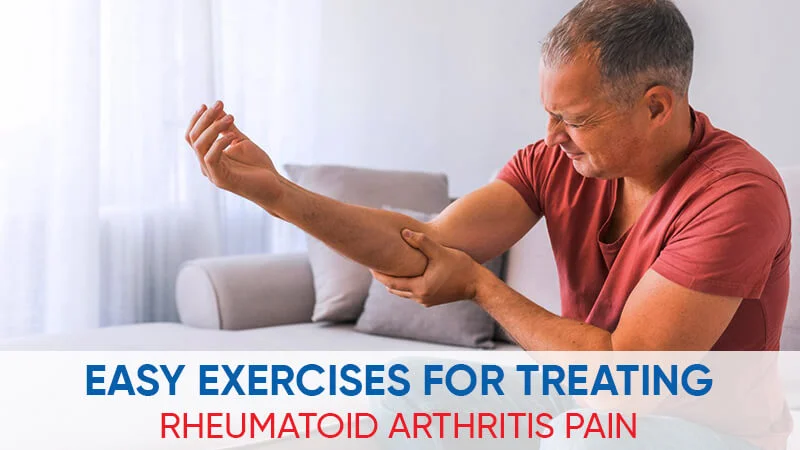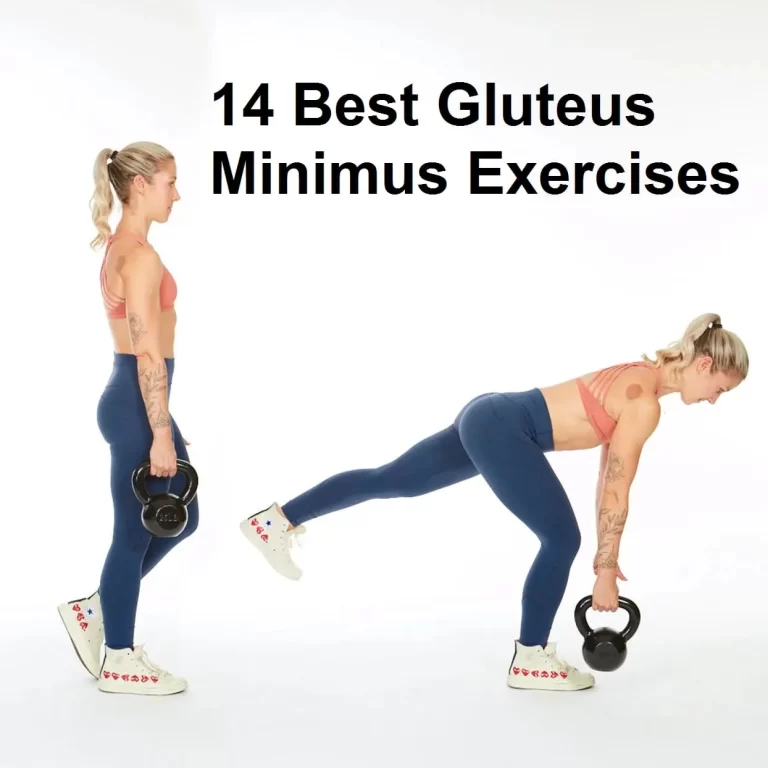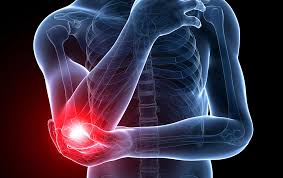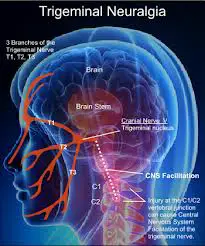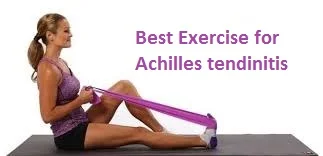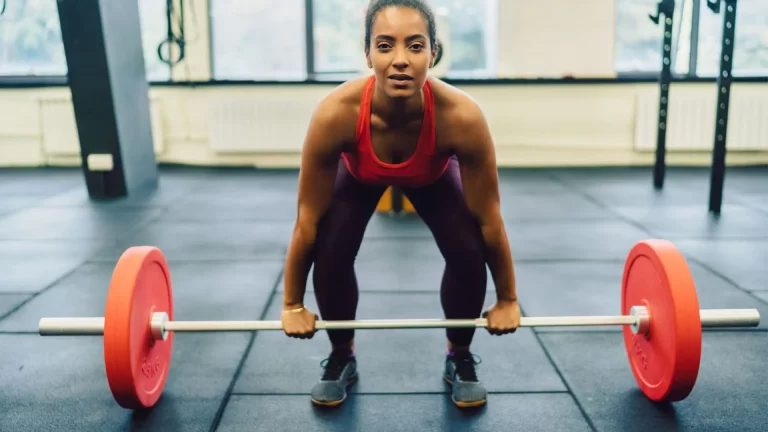9 Best Exercise for Rheumatoid Arthritis
Exercise is a vital part of healthy joints, particularly for individuals with rheumatoid arthritis (RA). This chronic autoimmune disease induces pain, swelling, and stiffness in the joints and can even impact other parts of the body. While it may appear counterintuitive to keep pushing when your joints are in pain or inflamed, routine exercise as part of an RA therapy plan can assist reduce symptoms and enhance overall physical function. This article gives you knowledge of the types of exercise that are suggested for people with RA and offers advice on how to maintain your joints safely while staying active.
Many individuals with rheumatoid arthritis care to avoid training because they are fearful that the move might exacerbate their joint pain. However, one of the most effective treatments for the impairment usually linked to rheumatoid arthritis is training. Frequent exercise can increase strength and flexibility in people who have rheumatoid arthritis. More powerful muscles can sufficiently support your joints, while enhanced flexibility can help joints Exercise can relieve fatigue and ease sadness. And better overall fitness helps control heart disease and diabetes, two life-shortening conditions that often accompany rheumatoid arthritis.
What is Rheumatoid arthritis?
Rheumatoid arthritis is a condition that induces inflammation in specific parts of the body—especially your hands, wrist, and knee joints. The tissue in the joint evolves harmed because your immune system attacks healthy cells by mistake. Additionally, rheumatoid arthritis causes the loss of muscle mass that comes with aging. That is why it is important to do workouts that will build muscle, in addition to aerobic activities, which support your heart and lungs. Walking and other weight-bearing exercises can help prevent osteoporosis, a condition that can arise from rheumatoid arthritis. Investigations show that training will not worsen rheumatoid arthritis symptoms. But if rheumatoid arthritis has hardly damaged your hips or knees, you may want to select low-impact exercises, such as swimming, water aerobics, walking, or bicycling.
This can induce symptoms such as:
- Exhaustion
- Joint discomfort or aching
- Join immobility
- Tenderness in the joints
- Weight losing
- Weakness
Benefits of physical activity for RA, including:
- Reducing joint aches and inflammation
- Making and supporting muscle strength
- Improving joint flexibility
- Assisting in weight loss
- Enhancing physical function and quality of life
- Reducing the risk of heart disorder
- Decreasing exhaustion and depression
- Improving sleep quality
How Extensively Physical Activity Should You Get?
The Centers for Disease Control and Prevention (CDC) suggests most grown-ups get either 140 minutes of moderate-intensity aerobic exercise or 70 minutes of vigorous-intensity aerobic exercise every week. But, for individuals with RA, your workout routine may look a little varied. Request a healthcare provider how much exercise they suggest for you. In addition, you should also perform muscle-strengthening, flexibility, and corrective exercises as well these are essential to maintaining your joints healthy.
The best aerobic exercises for those with rheumatoid arthritis are low-impact ones like swimming, cycling, or walking. Here we describe some low-impact exercises that can keep you physically involved and help to enhance rheumatoid arthritis signs. While it is expected for arthritic joints to sense a little discomfiting during certain activities, avoid actions that begin sharp pain or induce moderate to severe pain, particularly after exercising is completed (pain after training should not be more harmful than before training). If taking a workout class, request the instructor to suggest ways to adjust exercises that generate pain.
The varieties of exercises that a physical therapist instructs or supports for someone will RA will differ by person depending on factors like:
- Involved joints
- Joint strength
- Inflammation grades
- History of joint replacement surgery or other processes
- Additional existing health disorders
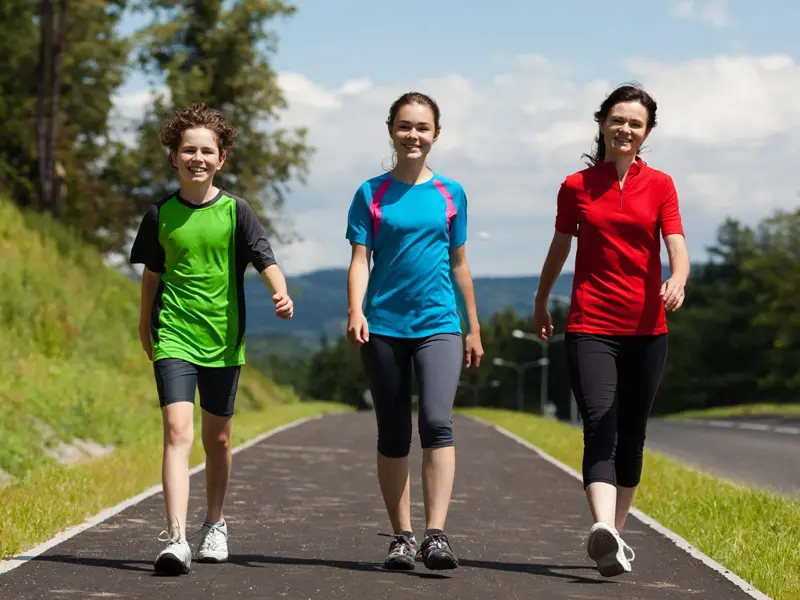
Here we describe the best exercise for rheumatoid arthritis:
Walking
This is a low-impact activity that can support aerobic movement, heart and joint health, and mood. It is important to wear appropriate shoes and stay hydrated if the walking is not severe. Begin walking gradually initially and then raise the pace when possible.
General mobility exercise
Mobility activities can add additional uses to exercises by supporting joints, connective tissue, and certain muscle groups more effectively than other forms of exercise. This can make mobility routine even more useful at keeping us healthy and pain-free as we age.
Arm and Shoulder Circles
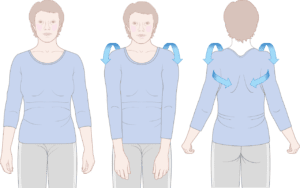
These are simple shoulder mobility exercises that almost everyone can do. They support activating the shoulder muscles and the entire shoulder joint, allowing prevent shoulder pain and stiffness.
- Your shoulders should be slightly pulled back as you stand up straight and keep your feet in parallel alignment.
- Put your shoulders shoulder-width apart and extend your arms.
- Your thumbs should be straight out in front of you while you keep your palms open but curl your fingers into them.
- Make little circular motions from your shoulder joints while maintaining a straight elbow position.
- Shift into a backstroke by turning your palms upward.
- Complete whichever many sets you feel comfortable with.
Chest and Shoulder Opener
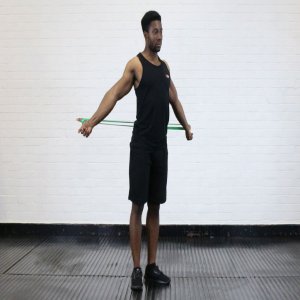
This is a perfect exercise for those who have inadequate posture or limited flexibility in the thoracic spine. It is best performed using a resistance band.
- Put your feet apart and stand straight up.
- Be sure to maintain a neutral head and spine.
- At waist level, extend the resistance band in front of you.
- Return the band in front of you after swinging it over your head until it is level with the base of your spine.
- Allow your shoulders and chest muscles to perform all the work; avoid arching your back.
- 20 repetitions should stretch the shoulders, upper back, and chest.
Hamstring and Hip Opener
This exercise allows the stretch of the hamstring muscles and unlocks the hips. It is a great mobility exercise for reducing hip and hamstring tightness and pain. For this activity, you will require a floor mat.
- lay on your back on the mat, unwind your shoulders, and then lower yourself to the ground.
- Keep your pelvis and feet on the ground while bending your knees.
- Lower back arches as you inhale.
- Release the arch as you exhale.
- After six repetitions, reset the position to neutral.
- Keeping your body neutral, extend your right leg upward.
- Put a resistance band in the middle of your foot’s sole.
- Put your left leg straight and on the ground.
- Pull the resistance band just a little bit, then hold the position for a few minutes.
- Switch to your left leg and stay in that position for however long feels comfortable.
- cross your right ankle over your left knee and let your knees fall to one side until they are at ground level to perform the hip mobility exercises. After that, switch sides and perform 10 times these mobility stretches.
3-Way Ankle Joint Mobilization
Strong ankles are crucial because they can withstand the daily stress of human activity. Make sure to include activities that improve ankle mobility in your mobility training program.
- Keep your right leg in front of you bent at the knee, and place the knee of your left leg on a small, thick gym mat.
- The right palm should be on your knee.
- Your right hand should be applied pressure to the knee as you push down.
- Alternate legs after a slight forward and backward knee bend.
- Each leg must complete 20 repetitions.
- You may move the knee in three directions: forward, left, and right.
Hip Circles
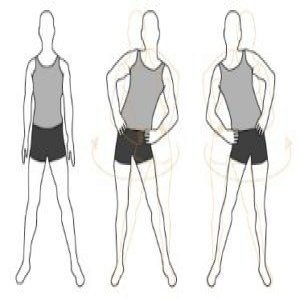
This is a quick and painless exercise that can be performed anywhere, and as the title suggests, they are an adequate exercise for hip mobility. With your feet spread apart, stand up straight.
- Your hands should be on your hips.
- Continuously circle while moving your hips.
- Change your direction.
- The ideal is a set of 20 in each direction.
Frog Squat
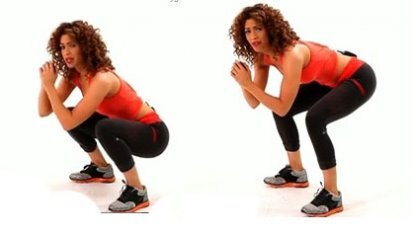
- Anyone can perform the Frog Squat, which is a straightforward mobility exercise that requires nothing for any special gym equipment. It concentrates on the quads, glutes, and hamstrings. Because the knees bear some of the squat’s weight, it’s also regarded as a fantastic exercise for improving knee mobility.
- Remain upright.
- 45-degree angles should be made in your toe rotations.
- As you sit or squat, squeeze your hands together and downward.
- Hold the position, then lift yourself halfway up, then squat back down.
- There should be 3 sets of 10 repetitions.
Hitchhiker
The Hitchhiker is an excellent exercise for people who have pain in their shoulders, upper back, or neck. Even headaches and tension can be reduced by using it. In addition to helping to improve and prevent bad posture, it strengthens the muscles in the upper back.
- Make a fist with your thumbs facing outward as if you were a hitchhiker by standing up straight.
- Grab a tension band with your right hand on one end and your left hand on the other.
- Stretch the tension band by rotating your arms outward while keeping your elbows tucked down at your sides.
- Hold the position before going back to where you started the place.
- The upper back and chest can be stretched out in three sets of ten repetitions.
Ball squeeze exercise

Put the ball between your index and thumb. Bring your thumb in towards your index finger to squeeze the ball. Pinch the ball with the tips of your fingers and thumb. With your fingers and thumb straight and your knuckles bent, squeeze the ball.
Stretching exercises
According to the Arthritis Foundation, stretching can assist enhance flexibility, relieve stiffness, and improve range of motion. The perfect stretching routine will vary for each person and depend on which joints are involved and their symptoms. Generally, stretches involve pushing the joints of the knees, hands, and elbows gently and slowly. A regular stretching routine may consist of the subsequent: Warming up by stepping on the spot or pumping the arms while sitting or standing for 4–5 minutes. Maintaining each stretch for 20–30 seconds before removing it. Repeating each stretch 3–4 times. Utilizing a yoga strap might help individuals maintain proper shape while stretching.
Gentle Shoulder, Elbow, and Wrist Stretches:
Brushing teeth, moving a car, and other daily activities can be difficult when RA affects the wrists, elbows, or shoulders. These activities are designed to reduce those joints and promote better arm and wrist position.
Wrist flexion and extension
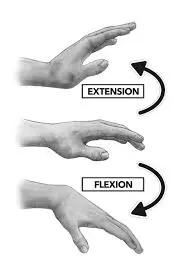
The carpal joints in the wrist are mainly susceptible to RA inflammation. To reduce stiff wrists, try this flexion and extension stretching: Keep your arms straight out in front of you, palms down.
- Your hands should form fists. Your fists should go lower as you flex your wrists, then back up and towards you as you extend your wrists.
- Repeat ten to twenty times.
- Lower your arms to a more comfortable angle if you’re having trouble keeping them raised due to shoulder joint pain.
Wrist rotation
- This exercise is similar to wrist flexion and extension, but the fists are rotated in a circle rather than being moved back and forth.
- Go clockwise and anticlockwise in turn.
Forearm flip
- The muscles and tendons of the forearms may stiffen as a result of RA inflammation. This activity can help maintain and increase flexibility.
- Hold your arms by your sides with your elbows bent 90 degrees and your palms facing upward.
- Bending the elbows while doing so, turn the palms downward.
- 10 to 20 times, then stop.
Biceps stretching
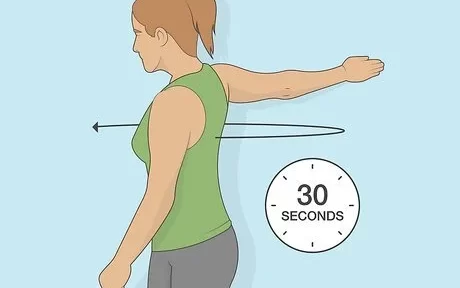
- Joint mobility is improved by using the whole range of motion when bending and straightening the elbows.
- Sit or stand with your arms at your sides, or as straight as you reasonably can.
- Put your fingers together behind your back.
- Keep your hands by your spine.
- Put your arms out straight.
- Extend your arms as far as you can.
- Hold for as long as a minute.
Gentle Stretches for the Foot and Ankle:
It can be challenging to move around if you have foot or ankle pain or stiffness. These symptoms may also alter one’s gait, such as a limp, which aggravates knee and hip issues. Try these exercises to reduce pain and lubricate the ankle and foot joints.
Ankle flexion and extension
- Before getting out of bed, perform this exercise while sitting in a chair or while lying down. When seated in a chair, move each leg independently and avoid resting weight on the foot that is actively moving. Reposition the legs.
- Flex your ankles such that your toes travel back and towards you while extending your ankles so that they point away from your body.
- 10 to 20 times, then stop.
- If this stretch is performed with the feet elevated, such as when resting down with a pillow under the feet, it could reduce swelling. This stretch helps improve ankle joint strength if performed while standing.
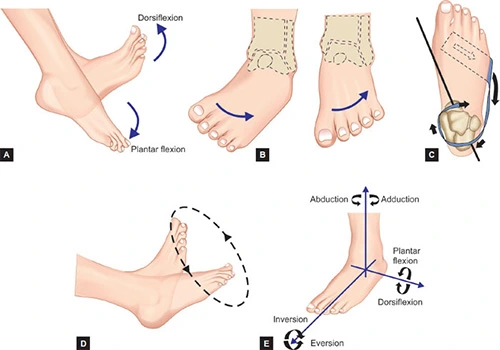
Ankle rotation
- Ankle flexion and extension exercises are similar to this one, except instead of moving the feet back and forth, rotate them in a circle.
- Try two sets of ten, one in each direction.
Toe curls

- The balls of the foot and other toe joints are susceptible to arthritis, especially rheumatoid and psoriatic arthritis.
- Toe curls can be performed before getting out of bed while sitting in a chair or even while lying down, similar to the ankle exercises mentioned above. Put no weight on the foot that is being used.
- Bending every toe inward and towards the sole
- The toes should be slowly uncurled, then extended up and back towards the top of the foot.
- 10 to 20 times, then stop.
Gentle Stretches for the Knee and Hip:
Although RA typically manifests first in smaller joints, larger joints can also be impacted. Whether a person wants to live independently without a walker, play golf once a week, or train for a five kilometers race, maintaining strong, flexible knees and hips will help them be as mobile as possible.
Knee to chest

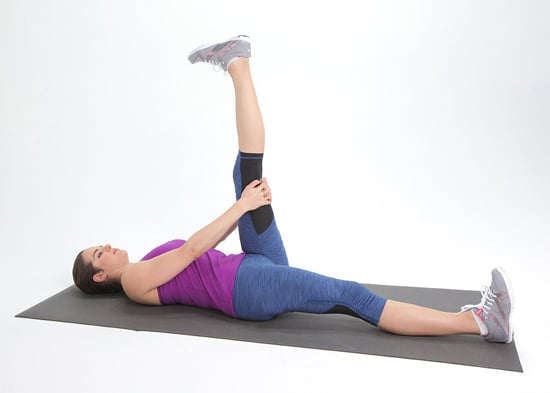
- You can perform this exercise in bed. The range of motion in the knees and hips is increased and maintained.
- Legs straightened, lie flat on your back. It’s alright to place a pillow under your head.
- Bending at the hip and knee, slowly slide your right foot towards your buttocks.
- Go back to the starting point
- similar action on the left side.
- Try elevating the feet off the ground and simultaneously bringing both knees to the chest after performing this movement numerous times. If it’s possible, hug the shins close to the chest with the arms.
Hamstring stretching

- With the legs completely extended, lie flat on a mat on the ground.
- Holding the back of the right knee with both hands, raising the leg towards the chest, and slowly straightening the knee until it feels stretched out is how you stretch the right leg.
- For 10 to 30 seconds, maintain the stretch.
Quadriceps stretching
- Your quadriceps muscle runs down the anterior thigh.
- To stretch your quadriceps: For support, place yourself next to a robust piece of exercise equipment or a wall.
- A stretch at the front of your thigh can be felt by holding onto your ankle and gently pulling your heel up and back.
Strength training

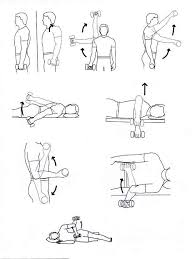
- Strengthening the muscles near the involved joints can help improve strength while relieving pain and different RA symptoms.
- Utilizing a resistance band is a course to contest the body and build muscle over time.
- A physical therapist who performs with people with RA should be able to offer advice on appropriate exercises.
Water exercises

- Water allows support body weight by underestimating gravity, which means that water exercises do not impact heavily on the joints.
- Swimming, water aerobics, and different gentle water exercises can improve flexibility, range of movement, strength, and aerobic training. Individuals often guide to these as forms of hydrotherapy. They can even ease joint stress and stiffness.
Cycling

- As RA raises the risk of cardiovascular illness increases, maintaining the heart as healthy as possible is important.
- Cycling can help enhance the cardiovascular process.
- Riding a static bike can be an effective reach to improve cardiovascular fitness and get the joints working.
- The use of a stationary bike is that an individual can exercise in a steady environment and under management if required.
- A person can also hang their bike outdoors to get refreshed air.
Taichi and yoga
- Both tai chi and yoga connect deep breathing, floating movements, gentle poses, and meditation.
- They improve flexibility, balance, and range of movement while also relieving stress.
- You may probably find free tai chi or yoga videos or applications online, including some that are designed just for people with RA.
- A person should always speak with their doctor before beginning a yoga or tai chi practice.

Pilates
- This is a low-impact exercise that can improve flexibility for improved joint health.
- performing Pilates poses that trigger the core muscles and highlight activities that help with stability can be useful.
- Pilates can be good for general movement patterns, comparable to tai chi and yoga.
- If conceivable, individuals new to Pilates should start slowly and seek advice from a certified coach.
Gardening and other activities
- These are Low-stress exercises and light gardening, which can help a person with RA. A person can avoid overstraining by avoiding flexing and twisting in ways that can pain the lower back. When bending over to work in the garden, a gardener should do so at the hips.
Tips for a workout with Rheumatoid Arthritis:
Because RA affects the joints and is an inflammatory condition, it is typically recommended to engage in low-impact activities that are kind to the joints to prevent symptoms from getting worse. The tips below may enhance protection and convenience when exercising with RA:
- Be consistent: It is necessary to exercise always to achieve meaningful results. An individual with RA will help from consistent and lifelong aerobic and muscle-strengthening activities.
- Seek diversity: People can avoid overworking one set of muscles or specific joints by performing a range of workouts and incorporating their daily routines.
- Listen to the body: Individuals with RA require to remain as physically involved as possible. Regardless, it is equally important to avoid pain or injuries. People can decrease exercise intensity on days when symptoms are more intense.
- Use the right equipment: Padded yoga mats, supporting footwear and clothing, and resistance bands can allow people to exert more comfortably.
- Work with a physical therapist: Working with a physical therapist specializing in RA can assist create safe and proper exercise training.
- Start gradually: start with ten minutes a day of light activity and raising that amount over time is a good way to train your joints to move.
- Don’t overdo it: Too much exercise can exacerbate or aggravate symptoms. Hear to your body, and do not be afraid to change activities to your powers that day.
Exercises to Avoid :
Individuals with RA and other forms of arthritis can always consult their training plans with a healthcare provider. Any actions that push a joint beyond its typical range of motion are typically prohibited because they can exacerbate the symptoms of RA. Unless it is cleared by your physical therapist, this means it is typically best for RA patients to avoid high-impact, harsh workouts like:
- Running
- Jumping
- Competitive sports
- Activities with impulsive changes in motion and direction
- Long-standing practices
- Weightlifting movements
FAQ
Which exercises should be avoided with RA?
Individuals with RA should evade severe exercise or any exercises that generate pain. However, RA is various for everybody, and there are no clear exercises that everyone with RA should avoid. For illustration, a person with RA in their hands might not be capable to exercise in the same way as an individual with RA in their feet.
Which actions worsen RA?
If performed improperly, high-impact exercises that affect twisting or squeezing joints may exacerbate RA symptoms. Performing with a professional to provide proper form and beginning slowly at low intensity can help an individual make a safe high-intensity routine.
Does workout lower inflammation in RA?
Exercise can decrease inflammation in RA, reduce pain symptoms and enhance flexibility.
Which is the best method to relieve arthritis?
Physical exercise is a simple and useful, drug-free way to reduce arthritis pain. Being physically involved can relieve pain, and enhance function, mood, and quality of life for adults with arthritis. Routine physical activity can contribute to enhancing sleep and support bone health, brain health, and weight control.
Can exercise flip RA?
Movement cannot reverse RA, but it can allow people to manage symptoms and enhance joint health.
How much training is too much with RA?
Every individual’s understanding of RA and exercise are various.But the majority of medical experts agree that exercise is probably too hard if it causes persistent pain that lasts beyond normal stiffness or discomfort. Hear your body and talk to a healthcare provider if you see unusual or persistent fatigue, joint swelling, pain, or weakness following activity.
Can I jog with Rheumatoid Arthritis?
Individuals with RA are motivated to participate in an exercise that is safe and suitable for them (and their joints). If light jogging does not induce additional pain or inflammation, it may be an activity that is cleared by your physical therapist.
Can I exercise during an RA burst?
It is usually adequate to stop exercising during an RA flare (a period in which signs intensify). Relaxing your body is important during a flare to help reduce common pain, inflammation, and swelling. If you always feel like living actively, check with a physical therapist first to see if the soft activity or light stretches are suitable for your situation.
What rheumatoid arthritis workout recommendations are there?
Adults with arthritis should aim for 75 minutes per week of strong aerobic exercise, such as cycling at 10 mph or faster, or at least 150 minutes per week of moderate aerobic activity, such as brisk walking.
Which activities are good for reactive arthritis?
Aerobic exercises that are comfortable on joints contain walking, bicycling, swimming, and water aerobics. Try to work up to 140 minutes of moderately hard aerobic workouts every week. You can exercise ten minutes at a time if that is easier on your joints.
Which is the best training for autoimmune disease?
Select low-impact exercises.
Think about activities like swimming, yoga, Pilates, weightlifting, and low-impact circuit training. Include cardio and aerobic activities that are appropriate for your skill level, such as dancing, elliptical training, step climbing, cycling on a stationary bike or outside, and rowing.
Can exercising help rheumatoid arthritis?
Exercise in general seems to improve overall function in RA without having any negative consequences on disease activity that have been established. Therefore, it should be suggested that all RA patients include some type of resistance and aerobic exercise training as part of their regular care.
What kind of lifestyle is ideal for autoimmune disorders?
Sugar, trans fats, alcohol, smoking, and other factors that cause inflammation should be avoided. Aim to reduce inflammation by engaging in frequent low-intensity exercise and consuming foods like coconut oil, avocados, olives, vegetables, herbs, salmon, and sardines.
What are the initial steps in treating rheumatoid arthritis?
Usually, methotrexate, often in conjunction with another DMARD and a brief course of steroids (corticosteroids) to relieve any discomfort, is the initial drug administered for rheumatoid arthritis. Together with biological therapy, these might be used. One of the common side effects of methotrexate is feeling unwell.

